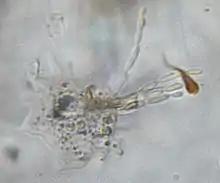Amoebophilus
Amoebophilus is a genus of zygomycete fungi that parasitizes amoeba.[2]
| Amoebophilus | |
|---|---|
 | |
| Thallus of Amoebophilus sp. infecting an unidentified amoeba. | |
| Scientific classification | |
| Kingdom: | Fungi |
| Subdivision: | Zoopagomycotina |
| Class: | Zoopagomycetes |
| Order: | Zoopagales |
| Family: | Cochlonemataceae |
| Genus: | Amoebophilus Dangeard (1910) |
| Type species | |
| Amoebophilus penardii Dangeard (1910)[1] | |
Morphology
Amoebophilus species are ectoparasites of amoeba. The thallus is composed of an internal haustorium that can be heart-shaped, globose, or lobose. Trailing chains of four or more conidia are produced from the haustorium. Zygospores are spherical at first and become polyhedral with age.[2]
Ecology
Amoebophilus species have been reported from forest and agricultural soils and freshwater ponds where they infect free living amoeba.[2][3][4][5] Infection begins when a conidium comes in contact with an amoeba. The conidium produces a penetration tube to invade the host and form the haustorium. Once the haustorium is formed, the conidium germinates and gives rise to a chain of conidia.[2] Due to difficulties in identifying amoeba, the host ranges of most species are unknown, with the exception of Amoebophilus simplex, which is restricted to species of Mayorella.[4][5]
Taxonomy
Amoebophilus species were first observed by Leidy in 1874 who mistook them as part of the amoeba and used them to describe a new genus. In 1902, Penard pointed out that the filaments observed by Leidy were in fact a parasite.[4] The genus was formerly erected by Dangeard in 1910 based on parasitized individuals of Pelomyxa vorax; he named the species after Penard.[2]
Species
- Amoebophilus penardii Dangeard
- Amoebophilus caudatus Dangeard
- Amoebophilus korotneffii Dangeard
- Amoebophilus sicyosporus Drechsler
- Amoebophilus dangeardii Miura
- Amoebophilus simplex Barron
References
- Dangeard, P.A. (1910). "Estudies sur les developpment des organisms infereurs. I. Les Amibes". Le Botaniste. 11: 4–57.
- Barron, G.L. (1983). "A new Amoebophilus (Zygomycetes) ectoparasitic on amoebae". Canadian Journal of Botany. 61: 3091–3094. doi:10.1139/b83-347.
- Drechsler, C. (1959). "Some conidial Phycomycetes destructive to terricolous amoebae". Mycologia. 51: 787–823. doi:10.1080/00275514.1959.12024861.
- Mrva, Martin (2008). "Infection of Mayorella penardi (Gymnamoebia) in oak-hornbeam forest soil by the ectoparasitic fungus Amoebophilus simplex (Zygomycota)". European Journal of Soil Biology. 44: 80–83. doi:10.1016/j.ejsobi.2007.05.005.
- Mrva, Martin (2011). "Mayorella vespertiloides Page, 1983 (Amoebazoa)--a new host for the ectoparasitic fungusAmoebophilus simplex (Zygomycota)". Biologia. 66: 645–647. doi:10.2478/s11756-011-0064-8.